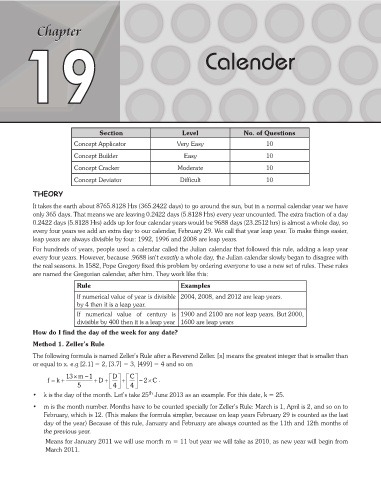Page 256 - Services Selection Board (SSB) Interviews
P. 256
Chapter
Chapter
19 Calender
Section Level No. of Questions
Concept Applicator Very Easy 10
Concept Builder Easy 10
Concept Cracker Moderate 10
Concept Deviator Difficult 10
THEORY
It takes the earth about 8765.8128 Hrs (365.2422 days) to go around the sun, but in a normal calendar year we have
only 365 days. That means we are leaving 0.2422 days (5.8128 Hrs) every year uncounted. The extra fraction of a day
0.2422 days (5.8128 Hrs) adds up for four calendar years would be 9688 days (23.2512 hrs) is almost a whole day, so
every four years we add an extra day to our calendar, February 29. We call that year leap year. To make things easier,
leap years are always divisible by four: 1992, 1996 and 2008 are leap years.
For hundreds of years, people used a calendar called the Julian calendar that followed this rule, adding a leap year
every four years. However, because .9688 isn’t exactly a whole day, the Julian calendar slowly began to disagree with
the real seasons. In 1582, Pope Gregory fixed this problem by ordering everyone to use a new set of rules. These rules
are named the Gregorian calendar, after him. They work like this:
Rule Examples
If numerical value of year is divisible 2004, 2008, and 2012 are leap years.
by 4 then it is a leap year.
If numerical value of century is 1900 and 2100 are not leap years. But 2000,
divisible by 400 then it is a leap year 1600 are leap years
How do I find the day of the week for any date?
Method 1. Zeller’s Rule
The following formula is named Zeller’s Rule after a Reverend Zeller. [x] means the greatest integer that is smaller than
or equal to x. e.g [2.1] = 2, [3.7] = 3, [499] = 4 and so on
D
−
C
×13 m 1
f = + + D + + −×
2C .
k
5
4
4
th
• k is the day of the month. Let’s take 25 June 2013 as an example. For this date, k = 25.
• m is the month number. Months have to be counted specially for Zeller’s Rule: March is 1, April is 2, and so on to
February, which is 12. (This makes the formula simpler, because on leap years February 29 is counted as the last
day of the year) Because of this rule, January and February are always counted as the 11th and 12th months of
the previous year.
Means for January 2011 we will use month m = 11 but year we will take as 2010, as new year will begin from
March 2011.

